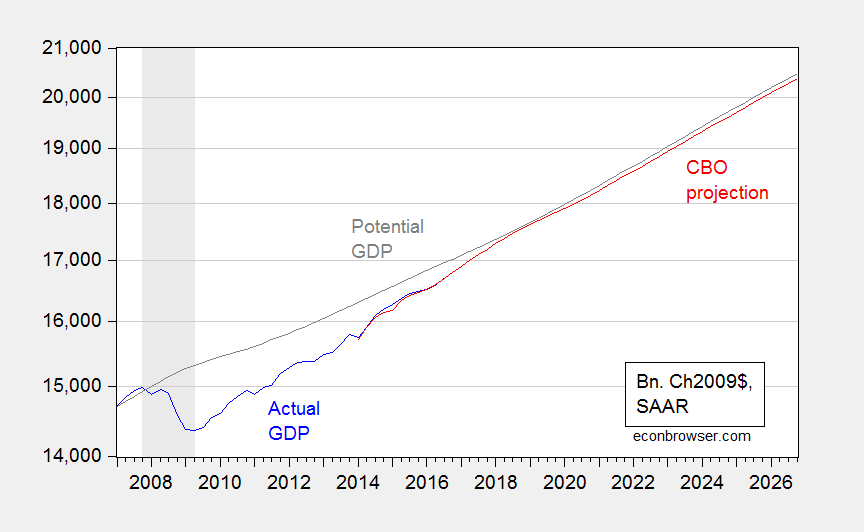As we get more clarity on the nature of fiscal and mass deportation policies under a Trump Administration, it seems useful to consider what happens to the output gap.
Figure 1 depicts the evolution of GDP and potential GDP as projected in the August 2016 CBO Budget and Economic Outlook.

Figure 1: Reported GDP (blue), projected (red), and potential GDP (gray), in billions Ch2009$ SAAR. Source: BEA 2016Q3 second release, CBO Budget and Economic Outlook, August 2016.
Goldman Sachs (Phillips, “US Daily: Fiscal Boost: Mainly a 2018 Story,” Dec. 8, 2016; not online) predicts 0.4-0.5 ppts higher growth in 2017Q4-2018Q1, 0.25 ppts for the remainder of 2018.
In September 2016, the Center for American Progress estimated a long run (approximately 10 years) reduction of potential GDP of 2.3% relative to baseline, arising from the deportation of 11.3 million undocumented individuals (7 million workers). (Note: American Action Forum estimates 5.7% reduction in output 20 years out [1])
I summarize these two effects in Figure 2.

Figure 2: Reported GDP (blue), projection incorporating Goldman Sachs estimates (red), and potential GDP incorporating deportation (gray), in billions Ch2009$ SAAR. Source: BEA 2016Q3 second release, CBO Budget and Economic Outlook, August 2016, Goldman Sachs (Dec. 8, 2016), Center for American Progress/Edwards and Ortega.
With this policy combination, output exceeds potential by 2018Q2. If CBO’s estimate of potential is too high, then potential is exceeded even earlier, and interest rates would tend to rise even faster than posited in this post. Dollar appreciation would be commensurately more pronounced.
Note I have assumed away fiscal cost of implementation of mass deportation (and hence expansionary Keynesian impacts on GDP); AAF estimates one-time costs at $100-300 billion, and 20 year costs at additional at $400-600 billion.
How do the numbers work out if you use GDP per capita, assuming a reduction in projected population growth? GDP alone is irrelevant. More important is GDP per capita.
Joseph: Don’t know – the estimates are in total GDP terms.
It would be pretty easy to figure out, right? Divide baseline GDP by baseline population, and divide counterfactual GDP by counterfactual population
Teapot: I could modify CBO baseline and potential. But impact on potential from mass deportations uses a different estimate of population, so would have to normalize each by different estimates of population. Goldman Sachs estimate of impact on output deviation has likely different estimate of population than used in CBO baseline. So it’s not as straightforward as you indicate. I could do it, but it would take some time — and I don’t think it would affect the bottom line. Do you?
Of course, there’s a positive relationship between education and income:
“Undocumented immigrants have lower levels of education than U.S. born residents in the same age range. Among all undocumented immigrants ages 25–64, 47% have not completed high school (compared with 8% of U.S. born adults in the same age range) and of these, more than half (29% of total) have less than a ninth grade education.”
do you just randomly cut and paste quotes without even the reference?
When people ask for them:
http://undocumentedpatients.org/issuebrief/demographics-and-socioeconomic-status/
thank you
I believe there will be something of a bait switch going on as this program gets implemented, as I expect that following a show of immigration enforcement and the creation of concentration camps for detainees, Puzder and Trump will organize a guest worker program similar to that used in the Northern Marianas and American Samoa and perhaps even the Dubai model:
1. Workers are brought in to work at low wages and kept in confined quarters (escapes will be classified a felony crime).
2. Subject to full exploitation by the employer, including sexual exploitation; https://books.google.com/books?id=H9hjj_U72T4C&pg=PA86&lpg=PA86&dq=Guest+workers+in+the+Marianas&source=bl&ots=vKPjx4Y6j3&sig=7qzAOEq3qARlV3THU_ZPYCUWVSg&hl=en&sa=X&ved=0ahUKEwj0w_H_5PbQAhXLPCYKHQBqBvYQ6AEIUTAI#v=onepage&q=Guest%20workers%20in%20the%20Marianas&f=false and
3. No chance or opportunity to become American citizens or permanent resident aliens for themselves or any children born while present in American territory; and
4. Troublemakers will be subject to transfer to deportation detention camps and eventual deportation.
But patriotic libertarians will be thrilled because the American Makers will have FREEDOM!!
One intended consequence of not deporting illegals is, of course, the apportionment of representatives in the U.S. House… and the votes in the Electoral College. Both use total population by state, citizen or not, in that apportionment.
Based on various estimates including this one by The Washington Post (https://www.washingtonpost.com/blogs/govbeat/wp/2014/11/21/the-undocumented-immigrant-population-explained-in-7-maps/?utm_term=.c98e6d0d99aa) states with the highest percentage of illegals (Texas a prominent exception) tend to be Blue states. Removal of the illegals (or a strict count of citizens only) would shift a number of representatives and Electoral votes from Blue to Red states.
While this is not a straightforward economic issue, it is a power and influence issue, and the money tends to follow power and influence.
“states with the highest percentage of illegals (Texas a prominent exception) tend to be Blue states.”
red states are well represented as well.